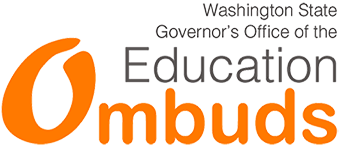2. Understanding the Public School System
The Washington State constitution says: “It is the paramount duty of the state to make ample provision for the education of all children residing within its borders…”
Education is a basic constitutional right in Washington. Students cannot be denied an equal educational opportunity because of their race, national origin, disability, pregnancy, or juvenile court involvement. Young people have a right to educational services until they are 22 years old. These services can be provided in a regular high school, an alternative high school, a GED program, or a high school completion program at a local community college.
How big is the Washington State Public School system?
Look at the bigger picture. There are 295 school districts and 2,278 school buildings in the state of Washington. School districts can include just one school or, as in the case of the Seattle School District, as many as 100 schools. There were 1,077,339 students enrolled in public schools in the year 2022.
Over 75% of students are enrolled in Western Washington school districts. Nearly one quarter of Washington’s public-school students are enrolled in King County.
Where do school districts get their money?
They access state, federal, local and private sources. Budget percentages in school districts vary. Here is an example:
70% from state funds.
10% federal funds for special programs such as Title I and bilingual education.
16% local property taxes as approved by voters.
4% other sources such as grants.
What is a Levy?
Levies are approved by voters. In addition to state, federal and private sources, school districts raise money for schools by asking local voters to pass school levies. Levies are local property taxes that homeowners in each city approve by vote. These local levies usually make up 15 – 20% of the school district budget.
What does the School Board do?
School Board Directors play a most important role. School board members (also called Directors) are elected by citizens of their communities. There are five members on a school board except in the state’s largest district, Seattle Public Schools, where the board has seven members.
School Board positions are unpaid although some Directors are reimbursed for their expenses in some districts.
Together, the Board makes decisions that affect staff and students in their school district such as policies, procedures, and district budget expenditures.
Other important roles include hiring and evaluating the Superintendent, creating a vision, setting goals for the school district and representing voters of their community.
Call your Board
You can call your Board members and let them know your ideas, concerns, or how particular district policies directly affect your student. School Board members want to hear from voters. Always send a letter to back-up your phone or in-person conversation with a school board member.
What does the Superintendent do?
They run the school district. The Superintendent is hired and evaluated by the School Board. They manage the daily operations of the school district, hire and supervise principals, develop the annual budget for School Board approval and oversee staff and academic programs.
What does “local control” mean?
Each school district is different. Citizens in each school district elect school board members. School Boards set policies and make decisions on a broad range of education issues within their own particular district. This is called “local control.” This is why policies, procedures and school programs can vary from one school district to another in the state of Washington.
What are School District Policies?
Know and follow district policies. Each School Board develops and adopts a set of rules to provide standards for staff and students in the district. District Policies (or Board Policies) cover a number of topics including district operations, academic programs, curriculum, enrollment, attendance, discipline, etc.
District policies are public documents and can be viewed by anyone. They are typically available at the district’s central offices or on the district’s website. Most districts have a clerk that works for the School Board and answers questions from the public.
What if my district policies don’t work or don’t exist?
You can influence change. Only the School Board can create new policies or make changes to existing ones. The voices of parents, family members and voters, in general, are very important in the public education system. You can make a big difference in the quality of students’ education by speaking out about what is needed in the school district and why.
Make sure you take time to read and understand district policies and procedures before personally or publicly approaching Board members or district administrators.
